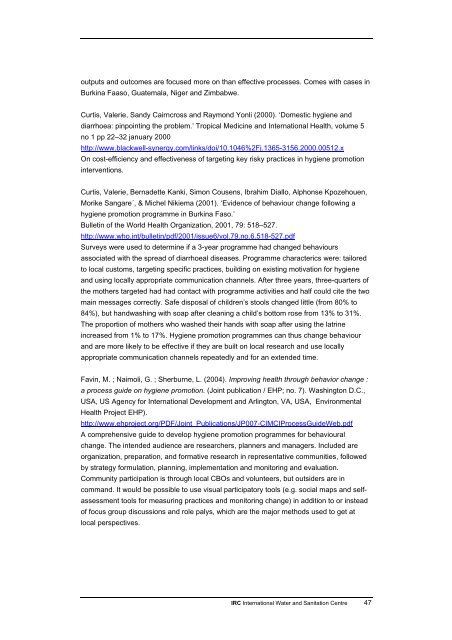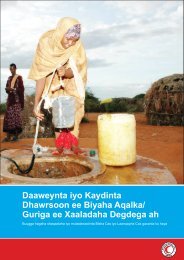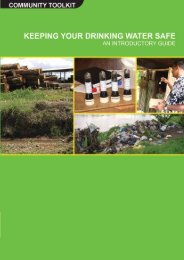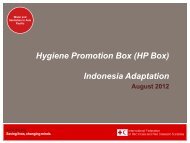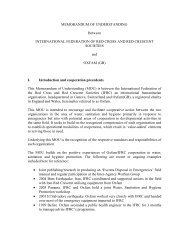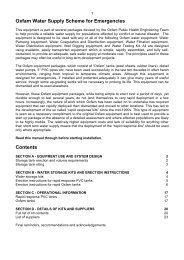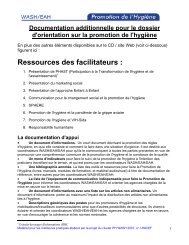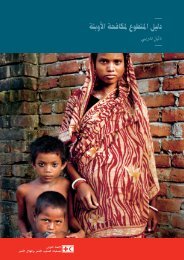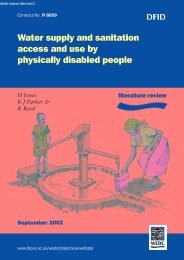Hygiene Promotion - IRC International Water and Sanitation Centre
Hygiene Promotion - IRC International Water and Sanitation Centre
Hygiene Promotion - IRC International Water and Sanitation Centre
You also want an ePaper? Increase the reach of your titles
YUMPU automatically turns print PDFs into web optimized ePapers that Google loves.
outputs <strong>and</strong> outcomes are focused more on than effective processes. Comes with cases inBurkina Faaso, Guatemala, Niger <strong>and</strong> Zimbabwe.Curtis, Valerie, S<strong>and</strong>y Cairncross <strong>and</strong> Raymond Yonli (2000). ‘Domestic hygiene <strong>and</strong>diarrhoea: pinpointing the problem.’ Tropical Medicine <strong>and</strong> <strong>International</strong> Health, volume 5no 1 pp 22–32 january 2000http://www.blackwell-synergy.com/links/doi/10.1046%2Fj.1365-3156.2000.00512.xOn cost-efficiency <strong>and</strong> effectiveness of targeting key risky practices in hygiene promotioninterventions.Curtis, Valerie, Bernadette Kanki, Simon Cousens, Ibrahim Diallo, Alphonse Kpozehouen,Morike Sangare´, & Michel Nikiema (2001). ‘Evidence of behaviour change following ahygiene promotion programme in Burkina Faso.’Bulletin of the World Health Organization, 2001, 79: 518–527.http://www.who.int/bulletin/pdf/2001/issue6/vol.79.no.6.518-527.pdfSurveys were used to determine if a 3-year programme had changed behavioursassociated with the spread of diarrhoeal diseases. Programme characterics were: tailoredto local customs, targeting specific practices, building on existing motivation for hygiene<strong>and</strong> using locally appropriate communication channels. After three years, three-quarters ofthe mothers targeted had had contact with programme activities <strong>and</strong> half could cite the twomain messages correctly. Safe disposal of children’s stools changed little (from 80% to84%), but h<strong>and</strong>washing with soap after cleaning a child’s bottom rose from 13% to 31%.The proportion of mothers who washed their h<strong>and</strong>s with soap after using the latrineincreased from 1% to 17%. <strong>Hygiene</strong> promotion programmes can thus change behaviour<strong>and</strong> are more likely to be effective if they are built on local research <strong>and</strong> use locallyappropriate communication channels repeatedly <strong>and</strong> for an extended time.Favin, M. ; Naimoli, G. ; Sherburne, L. (2004). Improving health through behavior change :a process guide on hygiene promotion. (Joint publication / EHP; no. 7). Washington D.C.,USA, US Agency for <strong>International</strong> Development <strong>and</strong> Arlington, VA, USA, EnvironmentalHealth Project EHP).http://www.ehproject.org/PDF/Joint_Publications/JP007-CIMCIProcessGuideWeb.pdfA comprehensive guide to develop hygiene promotion programmes for behaviouralchange. The intended audience are researchers, planners <strong>and</strong> managers. Included areorganization, preparation, <strong>and</strong> formative research in representative communities, followedby strategy formulation, planning, implementation <strong>and</strong> monitoring <strong>and</strong> evaluation.Community participation is through local CBOs <strong>and</strong> volunteers, but outsiders are incomm<strong>and</strong>. It would be possible to use visual participatory tools (e.g. social maps <strong>and</strong> selfassessmenttools for measuring practices <strong>and</strong> monitoring change) in addition to or insteadof focus group discussions <strong>and</strong> role palys, which are the major methods used to get atlocal perspectives.<strong>IRC</strong> <strong>International</strong> <strong>Water</strong> <strong>and</strong> <strong>Sanitation</strong> <strong>Centre</strong> 47


